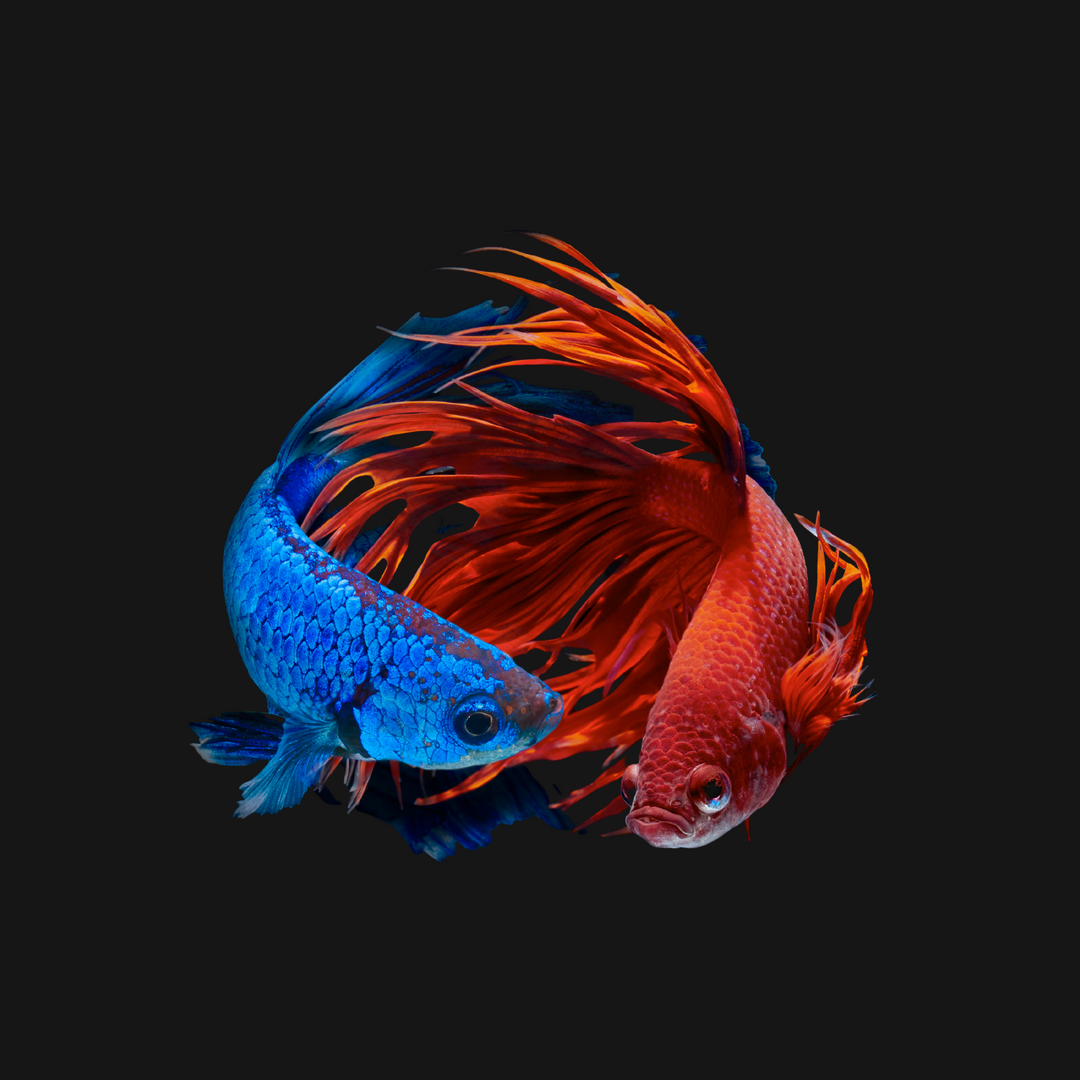King Betta vs Giant Betta

When choosing the perfect large betta for your aquarium, we find a dilemma: King Betta or Giant Betta? The turmoil begins with uncertainty about which of these extraordinary variants to choose and the differences between them.
Both are beautiful, but they also bring specific care and exclusive needs. This article will explore the differences between king betta and giant betta, their maintenance, and care. Get ready to dive into the fascinating large bettas world and discover which one is the ideal choice for your tank.
Giant Betta
King Betta vs Giant Betta
Conclusion
FAQ
King Betta
The king betta is a Thai jewel among the incredible diversity of betta fish. With vibrant colors and majestic appearance, this Southeast Asian fish is a choice for aquarists with prior experience with bettas.
Origins and Background
You won't find these fish in the wild. Breeders create these bettas in captivity through careful and time-consuming work of breeding and selecting fish that exhibit the desired characteristics.
The origins of king betta are uncertain till this day. Some say they were created during the selection process for giant bettas, with the same original lineage coming from the fighting plakat (Betta splendens).
Other aquarists say that slightly larger than regular bettas were selected from the first plakats and then hybridized with other betta species like imbellis and mahachaiensis, thus creating a large, aggressive fish. Some even say that it came from the selection of fight Betta imbellis that were hibridized with Betta splendens to improve fighting abilities, such as rapid movement, short fins, and heightened aggression.
Distinctive Characteristics of the King Betta
King betta can be differentiated from other bettas by some characteristics such as size. These fish are generally close to or slightly larger than regular bettas (2–3 in). They are noticeably smaller than giant bettas.
Its body features the vibrant colors and intricate patterns typical of bettas created by selective breeding.
King Bettas are available in many fin patterns and colors, featuring a wide range of shades, from deep blues and fiery reds to iridescent greens. It is worth mentioning that even fish with the "long fin" pattern have shorter fins than other bettas, always resembling the plakat.
King Betta Behavior
These bettas have the same active and curious behavior as regular or giant bettas. Males can be incredibly aggressive and territorial when in community aquariums.
Females can tolerate themselves in aquariums known as "sorority tanks", that is, community aquariums for female bettas. In community aquariums, they coexist better with other fish than males.
King Betta Diet
These fish are carnivores, presenting the same nutritional and food needs as other bettas. Feed them quality food suitable for bettas at least three times a day.
Vary the diet by offering live, fresh, or frozen foods such as bloodworms and nauplii.
King Betta Care and Requirements
The care and requirements for keeping king bettas are the same as for other regular bettas; what changes is the size of the aquarium. As it is a larger fish, provide at least 5 gallons.
These fish need good quality water, free from ammonia and other unwanted compounds. Provide clean water with stable parameters. pH around 7.0 and temperature around 24 to 28 degrees Celsius.
Use an effective filtration system, with regular water testing and weekly maintenance to maintain water quality. Make sure you provide your king betta with an environment with everything he needs, places to explore, swim freely, and hide.
Giant Betta
Giant bettas are the largest betta fish, reaching up to 5 inches. They are highly coveted fish in the aquarium world due to their beauty and large size.
The color palette presented by giant bettas is very diverse, displaying different colors. Through careful selection and breeding by breeders, these fish are available in a range of varieties with different fin and body patterns.
Giant Betta Origins and Background
Giant betta was bred in captivity, through years of careful selection of breeding stock. Originating from the Betta splendens plakat, the giant betta is not found in nature.
We have an complete guideline talking about the origins and giant betta fish keeping, see more here.
Giant Betta Distinctive Features
The most notable feature of the giant betta is its impressive size. These fish can grow much larger than regular bettas, with some individuals reaching an incredible 5 inches. Its fins display the same flowing, exuberant impression as other varieties of Betta splendens.
Temperament and Behavior of Giant Bettas
Giant bettas display typical Betta aggression and territoriality. Although they can be tolerant of other species, they are aggressive towards other bettas.
To keep them in community aquariums, it is essential to guarantee ample space and a large number of hiding places, thus avoiding conflicts and stress. Check out the difference between male and female giant bettas here
Giant Betta Care and Requirements
Giant bettas have the same specific care needs as their counterparts. They thrive in tropical water conditions, with a temperature of 24 to 28 degrees Celsius and a pH close to neutral or tending to slightly acidic (6.8-7.0).
Effective filtration and maintenance are essential to ensure water stability and quality.
The diet for the giant betta should be varied, including high-quality pellets as well as fresh, live, or frozen foods.
King Betta vs Giant Betta
Knowing the difference between king betta and giant betta is essential to know which of the two fish is best for your aquarium. As much as they have things in common, these bettas will still have some special needs. Let's take a closer look at the differences and similarities between these two betta varieties.
Size and Appearance
Both bettas are notable for their aggressiveness, size, and beauty. Giant bettas are the largest bettas in the world, king bettas are just below.
Giant bettas sport an elegant body with large, showy fins. As they are more selected for the hobby, they display a wide palette of colors and different fin patterns. These colors and patterns are probably more striking in giant bettas because they have a greater genetic background from Betta splendens.
King bettas are also present in several varieties, with a wide range of colors, like those we see in king koi bettas. Most of these fish, probably because they have most of the Betta imbellis genes, their fins are more compact. Even so, we find varieties such as the half-moon king betta.
Temperament and Behavior
The two varieties of betta were developed to fight, which is why they both appear aggressive and territorial.
Even though they are naturally not very social, there is a big behavioral difference between individuals, especially giant bettas, where some are peaceful and can live in community aquariums without problems. Observe your fish's behavior to confirm its aggressiveness.
Some fishkeepers attest that the king betta can be more aggressive than the giant betta, presenting greater difficulty in living in tanks with other fish.
A tip is to always offer several hiding places in the aquarium. These hideaways can be formed with the help of decorations such as plants, driftwood, and rocks.
Care and Requirements
King bettas have the same care requirements as giant bettas. The only difference will be in the size of the aquarium, for giant bettas, we must use a minimum of 10 gallons for a solitary male.
The water parameters are the same, the ideal temperature is between 24 and 28 degrees Celsius and the pH is close to neutral.
Filtration and maintenance are essential in any aquarium, especially for giant bettas, which ingest large amounts of food, quickly degrading the water.
Diet and nutrition
Both enjoy a high-quality, varied diet. Offer plenty of food, especially for young fish.
It is important to avoid overfeeding, as this can cause digestive problems for the fish.
The reproductive process of king bettas and giant bettas is the same as for other bettas. The idea is to use a breeding aquarium, where we can monitor and create the ideal conditions for reproduction. It is essential to provide a secluded, quiet space that is free from stress.
The main difference from other bettas is the size of the breeding tank. Due to the larger size of these bettas, they require a large space, suitable for spawning and caring for the fry. The breeding tank for giants must be larger than that used for king bettas.
King and giant betta fry tank care can be more intensive concerning common bettas. The fry of these variants requires a greater amount of food and water changes to develop perfectly. The size of the growing tank also plays an important role, and it must be large enough to accommodate the growing offspring.
Conclusion
Now that you know the main differences between king betta and giant betta, it is clear that both variants have their characteristics. Which of the two will be best for you depends on your preferences, available space, and commitment to specific care.
Both bettas can be beautiful, active, and curious fish, and success in keeping them is linked to the aquarist's dedication to maintaining the aquarium and observing and caring for the fish.
If you want to know more about these incredible fish, check out our other articles!





Leave a comment